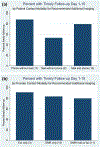Communication Practices of Mammography Facilities and Timely Follow-up of a Screening Mammogram with a BI-RADS 0 Assessment
- PMID: 29433892
- PMCID: PMC6402569
- DOI: 10.1016/j.acra.2017.12.028
Communication Practices of Mammography Facilities and Timely Follow-up of a Screening Mammogram with a BI-RADS 0 Assessment
Abstract
Rationale and objectives: The objective of this study was to evaluate the association of communication practices with timely follow-up of screening mammograms read as Breast Imaging Reporting and Data Systems (BI-RADS) 0 in the Population-based Research Optimizing Screening through Personalized Regimens (PROSPR) consortium.
Materials and methods: A radiology facility survey was conducted in 2015 with responses linked to screening mammograms obtained in 2011-2014. We considered timely follow-up to be within 15 days of the screening mammogram. Generalized estimating equation models were used to evaluate the association between modes of communication with patients and providers and timely follow-up, adjusting for PROSPR site, patient age, and race and ethnicity.
Results: The analysis included 34,680 mammography examinations with a BI-RADS 0 assessment among 28 facilities. Across facilities, 85.6% of examinations had a follow-up within 15 days. Patients in a facility where routine practice was to contact the patient by phone if follow-up imaging was recommended were more likely to have timely follow-up (odds ratio [OR] 4.63, 95% confidence interval [CI] 2.76-7.76), whereas standard use of mail was associated with reduced timely follow-up (OR 0.47, 95% CI 0.30-0.75). Facilities that had standard use of electronic medical records to report the need for follow-up imaging to a provider had less timely follow-up (OR 0.56, 95% CI 0.35-0.90). Facilities that routinely contacted patients by mail if they missed a follow-up imaging visit were more likely to have timely follow-up (OR 1.65, 95% CI 1.02-2.69).
Conclusions: Our findings support the value of telephone communication to patients in relation to timely follow-up. Future research is needed to evaluate the role of communication in completing the breast cancer screening episode.
Keywords: Screening mammography; communication; timely follow-up.
Copyright © 2018. Published by Elsevier Inc.
Figures


References
-
- Siu AL, Force USPST. Screening for breast cancer: U.S. preventive services task force recommendation statement. Ann Intern Med 2016; 164:279–296. - PubMed
-
- Zapka JG, Taplin SH, Solberg LI, et al. A framework for improving the quality of cancer care: the case of breast and cervical cancer screening. Cancer Epidemiol Biomarkers Prev 2003; 12:4–13. - PubMed
MeSH terms
Grants and funding
LinkOut - more resources
Full Text Sources
Other Literature Sources
Medical

